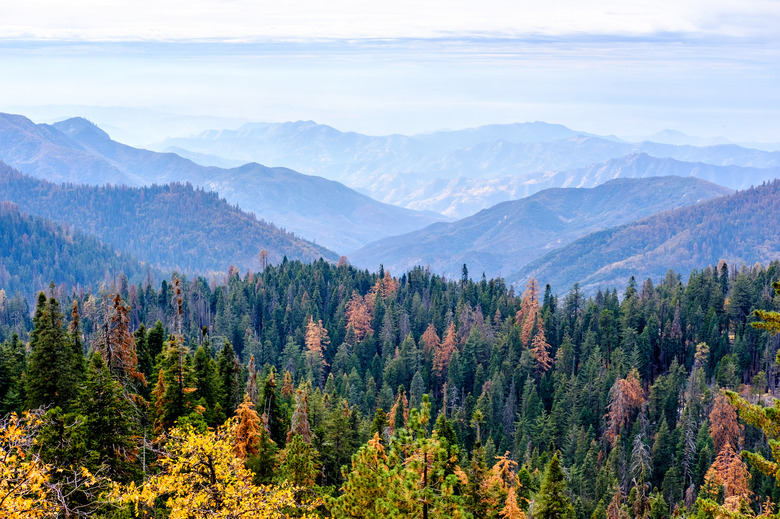Different Kinds Of Pine Trees In California
California pine trees (Pinus spp.) grow from the mountains to the sea. They soar to the sky and keep close to the ground. California pine trees are a significant part of the ecosystem and a distinctive part of the landscape. Pine trees are evergreen with long slender leaves that most people call needles. Pine tree identification by needles is only one identifying characteristic of these trees. Their height, the cones they produce, and the region where they're found are other identifying factors.
California Bishop Pine
The bishop pine (Pinus muricata, USDA zones 7-9) is a single-stem tree that grows on average to 70 feet high. It has green foliage, with needles growing in bundles of two, and bears orange flowers. It grows rapidly and most actively in spring and summer.
California Foothill Pine
The California foothill pine (Pinus sabiniana, zones 8-9) is a slow-growing pine that reaches 70 feet in height at maturity. It bears yellow flowers in the spring. Its needles, which grow to lengths of 8 to 12 inches, are bundled in threes. The needles are gray-green in color, which gives this tree its other common name of gray pine. Its cones are 6 to 14 inches.
California Coulter Pine
Coulter pine (Pinus coulteri, zones 8-9) produces very large cones that grow between 8 to 12 inches long and 6 inches in diameter. The needles grow in bundles of three. The coulter pine is a slow-growing tree that reaches a potential height of 80 feet. It exhibits its most active growth period in spring and summer. Yellow flowers bloom in late spring.
California Jeffrey Pine
Jeffrey pine (Pinus jeffreyi, zones 6-9) grows to a mature height of 130 feet. These pines tend to give off a vanilla or pineapple scent. The leaves grow in bundles of three needles, which are a gray-green color. The trees grow predominantly at an altitude of 5,000 to 7,000 feet above sea level.
California Monterey Pine
The Monterey pine (Pinus radiata, zones 7-10) produces leaves in bundles of three needles in lengths of 4 to 6 inches. In most instances, it grows 40 to 60 feet tall. However, some specimens grow to more than 100 feet high. Its native habitat is within 7 miles of California's Pacific coast.
California Ponderosa Pine
Ponderosa pine (Pinus ponderosa, zones 5-9) reaches 100 feet or more at maturity. The leaves, which are formed in bundles of three needles, grow to 7 inches in length. The bark is gray to black early in its life and later turns a yellow and black color with deep furrows. The Identification/Ponderosa_Pine_Pinus_ponderosa/'>University of California notes that the oldest known Ponderosa pine lived to be 600 years.
California Singleleaf Pinyon Pine
The leaves of singleleaf pinyon pine (Pinus monophylla, zones 6-8) are single needles that grow to less than 2 inches at maturity. This pine tree grows to 40 feet high in its natural habitat between 3,000 to 9,500 feet above sea level. The bark changes from smooth and gray to furrowed and reddish brown. Cal Poly's Urban Forest Ecosystems Institute notes that the singleleaf pinyon pine is one of the California pine trees with large cones. The cones produce edible pine nuts.
California Sugar Pine
Sugar Pine (Pinus lambertiana, zones 6-8) is the tallest of American pines, reaching a mature height of 200 feet. The needles appear in bundles of five. In many instances, the needles are twisted, with thin white lines.
California Torrey Pine
Torrey pine (Pinus torreyana, zones 8-10) is a rare tree in terms of its occurrence; it's one of the best pine trees for Southern California and now grows naturally in only a few places in that region. It's rare in that it is the only hard pine that develops five needles per bundle. The needles are long, averaging more than 7 inches. It produces edible pine nuts. The Torrey pine grows slowly, reaching a mature height of 50 feet.
California Western White Pine
Western white pine (Pinus monticola, zones 4-8) needles grow in bundles of five. Its cones are 8 to 15 inches long. This tree grows rapidly and reaches a height of 80 feet. The bark of an immature tree is grayish green and develops to a gray to purplish-gray bark as it ages.
